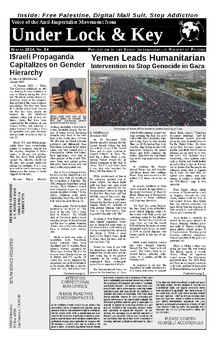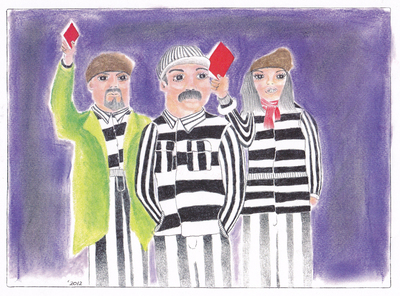
CA Strike Suspended: CDCR Will Not Meet 5 Core Demands
6 September 2013 — Yesterday, the Pelican Bay Short Corridor Collective released a statement announcing they had ceased their hunger strike to end torture in California prisons after two months. This came about two weeks after San Quentin prisoners had ceased their strike, announcing they'd entered into negotiations with the warden about conditions in the Administrative Segregation Unit (Ad-Seg). We do not yet have information on strikers at the Corcoran SHU, or anywhere else prisoners may still be striking. The California Department of Corrections and Rehabilitation (CDCR) reported that before the Short Corridor Collective stopped, 100 people were still on strike, 40 of whom had gone for two months straight.(1)
According to the Collective's statement, they have suspended their strike in response to a pledge by state legislators Tom Ammiano, Loni Hancock and Tom Hayden to hold a legislative hearing into conditions in the Security Housing Units (SHU) and the debriefing process. MIM(Prisons) is not optimistic of the outcome of such hearings. Ammiano held a hearing in August 2011 in response to the first of three mass hunger strikes around this struggle, and nothing changed, leading to the second hunger strike that October. Back in 2003, our comrades as part of the United Front to Abolish the SHU attended a legislative hearing on the conditions in the California SHU and the validation process. They published an article entitled, "CA senate hearings on the SHU: we can't reform torture." Ten years later, little has changed. These hearings keep happening, but they are little more than pacifying talks by those in power. The facts have been out there, the state has known what is going on in these torture cells. So what is the difference now? And how can we actually change things?
CDCR Done Addressing Problems
Before we look at how we can change things, let's further dispel any illusions that the CDCR or the state of California is going to be the source of this change. In the latest iteration of the strike, an additional 40 demands were drafted around smaller issues and widely circulated to supplement the 5 core demands. On 26 August 2013, the CDCR released a point-by-point response to the demands of those who have been on hunger strike since July 8. The announcement by the CDCR cites a 5 June 2013 memo that allegedly addresses many of these supplemental demands. Others are listed as being non-issues or non-negotiable.
As to the core demands, the CDCR once again disingenuously stated that they do not utilize "solitary confinement." Whatever they want to call it, holding people in tiny rooms for long periods of time (many have spent decades) without humyn contact, without being able to go outside, without any programs to engage in, is torture. They then put forth their new Security Threat Group (STG) program and Step Down program as answers to the central demands around long-term isolation and the debriefing process. We previously published an analysis of these programs exposing them as only offering more flexibility for the state to repress prisoners. In its short life, we have already begun to receive reports of prisoners being returned to SHU after participating in the Step Down program, confirming predictions that it would be the equivalent of a revolving door.
This CDCR announcement implies that we should not have hopes for negotiations or actions towards real change from CDCR. The Criminal Injustice System will not reform itself; we must force this change.
The Struggle Against Torture Continues
At first glance, the fact that this struggle has been waging for decades with little headway (especially in California) can be discouraging. However, our assessment of conditions in the imperialist countries teaches us that right now struggle against oppression must take the form of long legal battles, despite claims by the censors that we promote lawlessness. Sporadic rebellions with lots of energy, but little planning or longevity, do not usually create change and the conditions for armed struggle do not exist in the United $tates. We are therefore in strategic unity with the leaders who have emerged to sue the state, while unleashing wave after wave of peaceful demonstrations of ever increasing intensity. All of us involved have focused on agitation to shape public opinion and promote peace and unity among prisoners, and then using those successes to apply pressure to the representatives of the state. These are all examples of legal forms of struggle that can be applied within a revolutionary framework. Lawyers and reformists who can apply constant pressure in state-run forums play a helpful role. But make no mistake, prisoners play the decisive role, as the strikes are demonstrating.
Control units came to be and rose to prominence in the same period that incarceration boomed in this country. As a result, in the last few decades the imprisoned lumpen have been a rising force in the United $tates. Within the class we call the First World lumpen, it is in prisons where we see the most stark evidence of this emerging and growing class, as well as the most brutal responses from Amerikans and the state to oppose that class.
In California prisons in the last three years we've seen that with each successive hunger strike, participation has more than doubled. Just think what the next phase will look like when the CDCR fails to end torture once again! And as a product of this rising force in prisons, support on the outside has rallied bigger each time as well. As we said, this outside support is important, but secondary to the rising imprisoned lumpen.
Over 30,000 prisoners, one-fifth of the population in California, participated in this latest demonstration against torture. Many who didn't strike the whole time wrote to us that they, and those with them, were on stand-by to start up again. These grouplets standing by should be the basis for developing cadre. The 30,000 plus prisoners should be the mass base, and should expand with further struggle and education.
If you're reading this and still wondering, "what is it that MIM(Prisons) thinks we should do exactly?" — it's the same things we've been promoting for years. Focus on educating and organizing, while taking on winnable battles against the injustice system. Fighting to shut down the control units is important, but it is only one battle in a much larger struggle that requires a strong and organized anti-imperialist movement. We run our own study programs and support prisoner-run study groups on the inside. We provide Under Lock & Key as a forum for agitating and organizing among the imprisoned lumpen country-wide. We have study materials on building cadre organizations, concepts of line, strategy and tactics and the basics of historical and dialectical materialism. Each of these topics are key for leaders to understand.
Organizing means working and studying every day. In addition to the topics above, you can study more practical skills that can be used to serve the people such as legal skills, healthy living skills and how to better communicate through writing and the spoken word. Prisoners are surrounded by potential comrades who can't even read! We need Serve the People literacy programs. Combining these practical trainings with the political study and trainings promoted above will allow leaders to both attract new people with things they can relate to, while providing guidance that illuminates the reality of our greater society.
Principled organizing builds trust and dedication, which are two thing that comrades often report being in short supply in U.$. prisons. Principled organizing is how we can overcome these shortcomings. It is not an easy, nor a quick solution. The opponent we face is strong, so only by studying it closely and battling strategically will we be able to overcome it.
Whatever other tactics comrades on the inside decide to take to continue this struggle against torture, the need for building, organizing, and educating is constant and at the strategic level. Without that the movement does not strengthen or advance. If you're taking up this work, we want to hear from you and we want to support you in your efforts.









